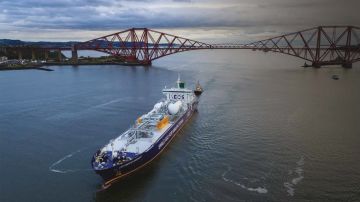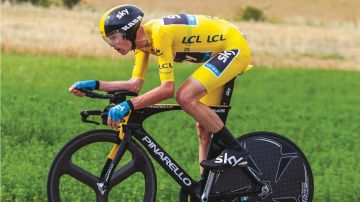Some may wonder what a man who spends most of his life at the ends of the earth can teach those of us who spend their lives mostly in an office. A lot, it seems, as INCH found out
NEITHER place sounds like heaven on earth.
The South Pole is the coldest, driest, remotest, windiest place on Earth. It is a lifeless, frozen desert with gusts of winds up to 90 miles an hour and is ringed by the world’s roughest seas.
The North Pole is all sea ice, constantly shifting, and miserably cold.
But Doug Stoup, a modern-day explorer, spends most of his life at one or the other. To him, it’s the office.
“I prefer the cold because you can always put on more clothes,” he said.
Last month the man, who has guided INEOS Chairman Jim Ratcliffe and his two sons, George and Sam, to both poles, took time out from planning his next expedition to talk to the team at INEOS’ new London HQ in Hans Crescent about taking risks in life and business.
“Organisation and preparation are the key to the success of any expedition,” he said. “I mitigate the risk. I can either accept the risk or turn around and walk away which I have done many times. I don’t have any problems doing that because I don’t have a death wish. Or I can transfer the risk and say ‘George, you go first.”
Although many in the audience laughed, Doug went on to explain.
“I don’t just sit there and watch the sky,” he said. “I watch every turn that he makes and learn from it.”
For Doug, being the best in business is also about taking risks, trust, teamwork, seeking new challenges and trying to do things differently. And it’s an approach he has seen many times at INEOS.
“A lot of the stuff INEOS does has a lot to do with pushing boundaries, and taking calculated risks,” he said. “And it is the reason the company is one of the most innovative and best in the world. I try to surround myself with a great team and so does INEOS.”
Doug’s love affair with the South Pole began in 1999 when he was in his early 30s.
“As a boy I never thought I would set foot in those places,” he said. “My dream was to climb and ski the highest mountain in Antarctica. But it was just a dream.”
Inspired, though, by the likes of Sir Ernest Shackleton, Captain Scott and Sir Douglas Mawson, he realised it was possible if he wanted it badly enough.
“I realised you can do anything you want to do if you put productive growth towards that dream,” he said.
In 1999, as he stepped off the plane on to an ice runway, he was overwhelmed.
“I just looked out over this vast nothingness,” he said. “I fell in love with the place and really could not wait to get back.”
During that first trip to the South Pole, he also discovered he was able to help others.
Ever since then he has been guiding people to the ends of the earth - both for pleasure or in the pursuit of scientific discovery.
Many of his companions are CEOs.
“They understand risks because they run their own worlds and make decisions every day but any experience they have in the business world really doesn’t apply in the Antarctic,” he said. “Money doesn’t apply either.”
What matters is that they are willing to listen, learn quickly, and prepare for what lies ahead – both mentally and physically.
“The only thing they cannot imagine is the cold,” he said. “And they will only understand that when they actually get there. You can perspire so much that your goggles freeze to your face.”
To prepare for his epic adventures, Doug often gains weight, knowing he will be burning 10,000 calories a day as they cross ice that would have been water a week earlier.
“You can lose 2,000 calories by just standing still,” he said.
He is a great believer in the resilience of the human body.
“It’s the mind that needs conquering,” he says. “If you train, you should be able to push your body to the limit. It is a mental barrier. You have to tap into that mental toughness if you want to stay one step ahead.”
Doug is often asked whether he would guide an expedition to the summit of Mount Everest, which at 29,035 ft is the world’s highest mountain.
But he’s not convinced it is for him.
“I am not sure I could do it because there are a lot of people who really don’t belong there,” he said. “You need to know when to stop and make the right decision for you own safety. It is not always about reaching the summit at all costs.”
He believes leaders in all walks of life share many qualities.
Compassion, an ability to understand other people’s personalities and thinking on the run are all important, says Doug.
“Strong personalities know how to adapt to both their environment and others,” he said. “To be a great leader, you also need to understand all the elements that are happening out there and take on board other people’s comments.”
Apart from the cold, the floating ice, the winds, is there anything else to fear?
Yes, he says, polar bears.
“They can smell a seal from eight miles away so they can certainly smell me when I have not showered in a month and a half,” he said.
Despite his meticulous planning, things can go wrong.
“Even as someone who has more experience of the poles than anyone on the planet, I still make mistakes,” he said. “My goggles once froze on my head, I have suffered from snow blindness and once when I broke a tooth, I had to pull it out with pliers.”
Can he see himself retiring?
No, he says. Not yet.
The father with three sons still has too much to see and do.
“Maybe one day one of them will take over from me,” he said.
MY HEROES
THE three men who continue to inspire Doug Stoup all lived at the turn of the century.
One died and two survived against all the odds.
“They are still my mentors,” he said. “They were true men who knew how to suffer.”
Sir Douglas Mawson staggered alone 165 miles back to his ship after one of his companions fell into a crevasse and the other died of food poisoning during an expedition in 1912.
Captain Scott and his two remaining companions, pinned down by a storm, froze to death in their tent 150 miles from base camp after reaching the South Pole in January 1912.
Three years later Sir Ernest Shackleton lived to tell the tale after his ship ‘Endurance’ became trapped in ice and sank. His crew had already abandoned the ship to live on the floating ice. The following year, Shackleton and five crew members went to find help. In a small boat, they spent 16 days crossing 1,300 km of ocean to reach South Georgia and then trekked across the island to a whaling station. The remaining men from the ‘Endurance’ were later rescued. Not one member of the crew died.
“They are the true heroes,” said Doug. “Once we have reached the South Pole, I call someone and they come and pick us up.”


















